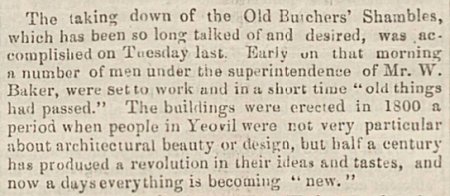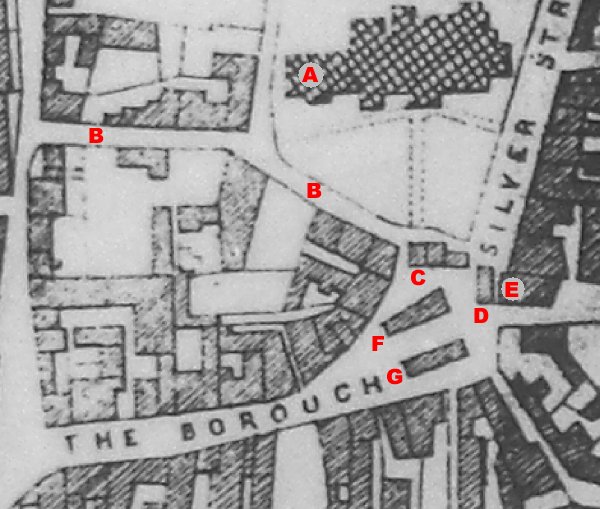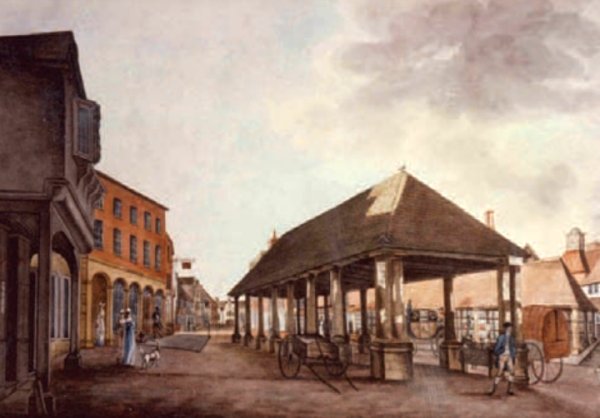The shambles
the shambles
The butchers' stalls in the Borough
In early times most towns would have a Flesh Shambles, a name probably derived from the Anglo-Saxon fleshammels, literally meaning 'flesh-shelves', the word for the shelves that butchers used to display their meat. Consequently 'Shambles' was an early term for an open-air slaughterhouse and meat market.
In the Borough there had been a shambles, the stalls in the public market where the meat was sold, since at least 1364. In this year was an action at law in which the Rector claimed that the land on which the shambles stood was part of the Rectory and he was therefore due its weekly tolls - the butchers each paid a penny a day for using the shambles. However the people of Yeovil claimed the land was part of the highway, in other words common land, for which no tolls were due. The Rector, Robert de Sambourne, also a Canon of Wells, produced a document signed by King Edward III (reigned 1327-1377) confirming his right to claim the fees from the shambles as well as his right to hold a weekly market each Friday "as having existed through the time of his predecessors beyond the memory of man."
It was claimed that the Rector had obtained the document by underhand means. As a consequence the King's Escheator, an officer of the King's appointed to ensure that the King got all his due fees, seized the shambles in the name of the King claiming that the land in dispute was part of the "Royal Road" that is, part of the King's Highway.
Robert de Sambourne appeared in person at the Chancery in Westminster to plead his case. He argued that as Rector and Lord of the Manor by right of his church, he held a market in the town every week. He also claimed that the waste land of the town belonged to the Rector and that the market stalls had been fixed on the land in question - 7 feet in breadth and 27 feet in length - by the bailiffs and men of the Parson of the Church "before the time of memory".
The matter was not settled at Chancery but referred to the local court at Ilchester. Robert de Sambourne won his case as it was determined that the Rector and all his predecessors held the lordship of the town, the rights to the market and the land in question. Further, the Escheator was ordered to return all the confiscated fees he had collected.
By the eighteenth century
there had been a
Market House in
High Street for
generations and
was described as
follows "It is
70 feet long and
20 feet wide,
supported by 20
stone pillars,
and in the
middle of it are
the remains of
an ancient
cross; there are
also several
rows of
shambles."
The nineteenth
century building
known as the Shambles
was a timbered
market building
with a tiled
roof situated in
the Borough in
the approximate
location of the
war memorial and
bus stops of
today's Borough.
It was built in
1803 by butcher
George
Watts and served
for nearly a
century and
half. It was
sometimes called
the Butchers'
Shambles because
it was used
exclusively by
the purveyors of
meat.
By the middle of
the nineteenth
century the
Shambles, as
well as the
adjacent
Market House,
had fallen into
disrepair and
their demolition
was the subject
at the first
meeting of the
newly set up
Special
Commissioners in
1846. Both the
Shambles and the
Market House
were demolished
in 1850 with the
Special
Commissioners
contributing
£200 towards the
costs.

Sherborne
Mercury, 11 June
1850
MAP

Day's map of
1831 showing the
Borough, plus a
few associated
features;
A = The
Chantry in
original
position,
B =
Church Lane
/ Street, C =
Tolle Hall,
D = Bow,
E =
London House,
F = The
Butchers'
Shambles, G =
Market House.
gallery

This painting
features in my
book 'Secret
Yeovil'
A painting made in 1810 of the Borough looking towards High Street which runs to the distance at left. The building at centre was the Market House, built in 1740, and behind it to the right was the butcher's Shambles, built in 1803. The Tolle Hall is seen at right, surmounted by its clock or 'horolitch'. At left, the building with the arched ground floor is the only building surviving today in the Borough and originally the ironmongery shop of William Edwards, then Josiah Hannam followed by James Bazeley Petter and then Hill & Sawtell. Today it is 15 High Street, occupied by Superdrug and is seen in the final photograph of this page. At extreme left is the ancient building, called The Bow (see next image) on the corner of today's Wine Street. Note, in the far right corner of the Shambles, the stocks - used for humiliating public punishment of minor offences.

An enlargement of the previous image showing more clearly the Butchers' Shambles situated behind the Market House.

This sketch, made by GE Madeley to illustrate his map of 1831, shows the Borough seen from High Street - roughly the view seen today from the north end of King George Street. The Shambles is to the left and the Market House is to the right. The buildings at far left still stand today, that to the left is Clement White's shop, today's 8 High Street, at this time occupied by draper Benjamin Ryall whose name appears above the door. Behind the hanging sign at right is the Medical Hall which at this time was occupied by George Wellington, druggist and chemist.